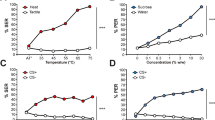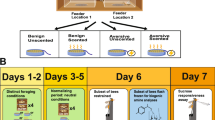Abstract
In honey bees, complex behaviours such as associative learning correlate with responsiveness to sucrose. In these behaviours, the subjective evaluation of a sucrose stimulus influences the behavioural performance. Habituation is a well-known form of non-associative learning. In bees, the proboscis extension response can be habituated by repeatedly stimulating the antennae with a low sucrose concentration. A high sucrose concentration can dishabituate the response. This study tests whether habituation correlates with responsiveness to sucrose in bees of different behavioural states and in bees which are habituated with different sucrose concentrations. Habituation and dishabituation in newly emerged bees, 5-day-old bees and foragers strongly correlated with responsiveness to sucrose. Bees with high responsiveness to sucrose displayed a lower degree of habituation and showed greater dishabituation than bees with low responsiveness. The degree of habituation and dishabituation also depended on the concentration of the habituation stimulus. These experiments demonstrate for the first time in a non-associative learning paradigm that the subjective strength of a sucrose stimulus determines the behavioural performance. Non-associative learning shares this property with associative learning, which suggests that the two processes might rely on similar neural mechanisms.




Similar content being viewed by others
Abbreviations
- GRS:
-
Gustatory response score
- PER:
-
Proboscis extension response
References
Bicker G, Hähnlein I (1994) Long-term habituation of an appetitive reflex in the honeybee. Neuroreport 6:54–56
Bortz J, Lienert GA, Boehnke K (2000) Verteilungsfreie Methoden in der Biostatistik, Springer, Berlin Heidelberg New York, pp 79–86
Braun G, Bicker G (1992) Habituation of an appetitive reflex in the honeybee. J Neurophysiol 67:588–598
Erber J, Kierzek S, Sander E, Grandy K (1998) Tactile learning in the honeybee. J Comp Physiol A 183:737–744
Frisch K von (1965) Tanzsprache und Orientierung der Bienen. Springer, Berlin Heidelberg New York
Guez D, Suchail A, Gauthier M, Maleszka R, Belzunces LP (2001) Contrasting effects of imidacloprid on habituation in 7- and 8-day-old honeybees (Apis mellifera). Neurobiol Learn Mem 76:183–191
Hawkins RD, Kandel ER (1984) Is there a cell-biological alphabet for simple forms of learning? Psychol Rev 91:375–391
Lambin M, Armengaud C, Raymond S, Gauthier M (2001) Imidacloprid-induced facilitation of the proboscis extension reflex habituation in the honeybee. Arch Insect Biochem Physiol 48:129–134
Lunney GH (1970) Using analysis of variance with a dichotomous dependent variable: an empirical study. J Educ Meas 7:263–269
Núñez JA, Giurfa M (1996) Motivation and regulation of honey bee foraging. Bee World 77:182–196
Page RE, Erber J (2002) Levels of behavioral organization and the evolution of division of labor. Naturwissenschaften 89:91–106
Page RE, Fondrk MK (1995) The effects of colony-level selection on the social organization of honey bee (Apis mellifera L.) colonies: colony-level components of pollen hoarding. Behav Ecol Sociobiol 36:135–144
Page RE, Erber J, Fondrk MK (1998) The effect of genotype on response thresholds to sucrose and foraging behavior of honey bees (Apis mellifera L.). J Comp Physiol A 182:489–500
Page RE, Fondrk MK, Hunt GJ, Guzmán-Novoa E, Humphries MA, Nguyen K, Greene AS (2000) Genetic dissection of honeybee (Apis mellifera L.) foraging behavior. J Hered 91:474–479
Pankiw T (2003) Directional change in a suite of foraging behaviors in tropical and temperate evolved honey bees (Apis mellifera L.). Behav Ecol Sociobiol 119:458–464
Pankiw T, Page RE (1999) The effect of genotype, age, sex, and caste on response thresholds to sucrose and foraging behavior of honey bees (Apis mellifera L.). J Comp Physiol A 185:207–213
Pankiw T, Page RE (2000) Response thresholds to sucrose predict foraging behavior in the honey bee (Apis mellifera L.). Behav Ecol Sociobiol 47:265–267
Pankiw T, Waddington KD, Page RE (2001) Modulation of sucrose response thresholds in honey bees (Apis mellifera L.): influence of genotype, feeding and foraging experience. J Comp Physiol A 187:293–301
Pflumm W (1969) Correlations between preening behaviour and foraging tendency in the honeybee. Z Vergl Physiol 64:1–36
Raveret-Richter M, Waddington KD (1993) Past foraging experience influences honey bee dance behaviour. Anim Behav 46:123–128
Scheiner R, Erber J, Page RE (1999) Tactile learning and the individual evaluation of the reward in honey bees (Apis mellifera L.). J Comp Physiol A 185:1–10
Scheiner R, Page RE, Erber J (2001a) Responsiveness to sucrose affects tactile and olfactory learning in preforaging honey bees of two genetic strains. Behav Brain Res 120:67–73
Scheiner R, Page RE, Erber J (2001b) The effects of genotype, foraging role, and sucrose responsiveness on the tactile learning performance of honey bees (Apis mellifera L.). Neurobiol Learn Mem 76:138–150
Scheiner R, Weiß A, Malun D, Erber J (2001c) Learning in honey bees with brain lesions: how partial mushroom-body ablations affect sucrose responsiveness and tactile learning. Anim Cogn 4:227–235
Scheiner R, Plückhahn S, Öney B, Blenau W, Erber J (2002) Behavioural pharmacology of octopamine, tyramine and dopamine in honey bees. Behav Brain Res 136:545–553
Scheiner R, Barnert M, Erber J (2003a) Variation in water and sucrose responsiveness during the foraging season affects proboscis extension learning in honey bees. Apidologie 34:67–72
Scheiner R, Müller U, Erber J (2003b) Activity of protein kinase A and gustatory responsiveness in the honey bee (Apis mellifera L.). J Comp Physiol A 189:427–434
Scheiner R, Page RE, Erber J (2004) Sucrose responsiveness and behavioral plasticity in honey bees. Apidologie 35:133–142
Schmid-Hempel P, Kacelnik A, Houston AI (1985) Honeybees maximize efficiency by not filling their crop. Behav Ecol Sociobiol 17:61–66
Seeley TD (1995) The wisdom of the hive. Harvard University Press, Cambridge
Thompson RF, Spencer WA (1966) Habituation: a model phenomenon for the study of neuronal substrates of behavior. Psychol Rev 73:16–43
Waddington KD (1997) Foraging behavior of nectarivores and pollen collectors. In: Richards KW (ed) VII International Symposium on Pollination (Acta Horticulturae 437). ISHS, Lethbridge, Alberta, Canada, pp 175–191
Zar JH (1999) Biostatistical analysis, 4th edn. Prentice Hall, New Jersey, pp 312–323
Acknowledgements
I would like to thank Siegrid Wiese for her help with the experiments and Joachim Erber for his helpful advice on this manuscript. This work was supported by a grant from the Deutsche Forschungsgemeinschaft (SFB 515). All experiments conducted comply with the current German guidelines for the proper treatment of animals.
Author information
Authors and Affiliations
Corresponding author
Rights and permissions
About this article
Cite this article
Scheiner, R. Responsiveness to sucrose and habituation of the proboscis extension response in honey bees. J Comp Physiol A 190, 727–733 (2004). https://doi.org/10.1007/s00359-004-0531-6
Received:
Revised:
Accepted:
Published:
Issue Date:
DOI: https://doi.org/10.1007/s00359-004-0531-6




